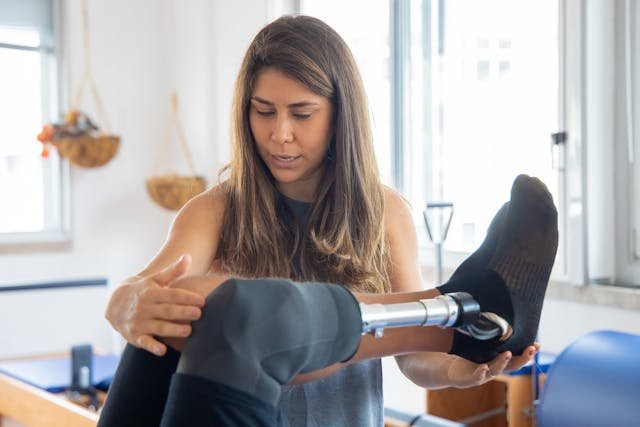For anyone living with an above-knee amputation, the prosthetic knee joint is the heart of the prosthesis. It does far more than simply replace a lost part of the leg—it plays a major role in how a person moves, balances, and feels in everyday life. Choosing the right prosthetic knee joint is one of the most important decisions in the recovery journey.
At Robobionics, we meet many users who are surprised to learn just how much the knee joint impacts their walking, comfort, and confidence. This article breaks down everything you need to know about prosthetic knee joints in simple, human terms. Whether you’re just starting to explore prosthetics or are considering an upgrade, understanding how these joints work will help you make the best choice for your lifestyle.
Why the Prosthetic Knee Joint Is So Important
Unlike below-knee amputees, above-knee amputees do not have a natural knee to support movement. That means the prosthetic knee joint has to do all the work. It needs to provide support when standing, allow bending when sitting, and help swing the leg forward while walking.
Replacing the Function of the Natural Knee
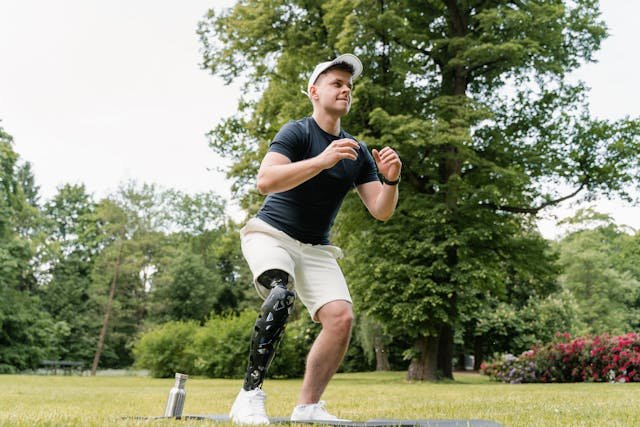
The natural knee is one of the most complex joints in the body. It allows us to bend, straighten, absorb shock, and balance as we walk or run. For an above-knee amputee, losing this joint creates a big gap in mobility. A prosthetic knee joint is designed to fill that gap, offering a mechanical or electronic system that mimics the bending and support of a real knee.
A good prosthetic knee doesn’t just bend and straighten. It helps control the speed of movement, prevents the leg from collapsing during walking, and keeps the user balanced during each step. Without a functional knee joint, even the best prosthetic foot or socket cannot offer a smooth walking experience.
At Robobionics, we help users understand that choosing the right knee is not about getting the most expensive option—it’s about finding a joint that works with your body, your strength, and your daily routine.
Supporting Balance and Stability
Walking without a knee joint is not just uncomfortable—it’s risky. The prosthetic knee joint provides crucial stability, especially when the body shifts weight from one leg to the other. It needs to stay firm during standing and flexible when bending, all while adjusting to uneven ground or quick turns.
Many users fear falling, especially in public or unfamiliar places. A high-quality knee joint helps reduce that fear by offering reliable support. Some knee joints lock during weight-bearing to prevent sudden buckling, while others use smart sensors to respond in real time to changes in movement.
The more stable the knee, the more confident the user feels. This makes a difference not just in how someone walks but in how they live—whether that means taking a bus, standing in a queue, or going for a walk with family.
Helping With Energy Efficiency
Walking with a prosthetic already takes more energy than walking with two natural legs. This energy demand becomes even higher when the knee joint doesn’t function properly. A well-designed knee joint helps manage this extra effort by supporting smooth, predictable movement.
Older or poorly-fitted prosthetic knees can cause users to compensate by swinging their hip more or leaning backward while walking. These habits can cause pain in the back, hips, or shoulders over time. A responsive knee joint reduces this strain, making every step more efficient.
By improving energy return and reducing muscle fatigue, the right prosthetic knee makes it possible for users to stay active for longer periods—whether at work, school, or home.
Understanding the Types of Prosthetic Knee Joints
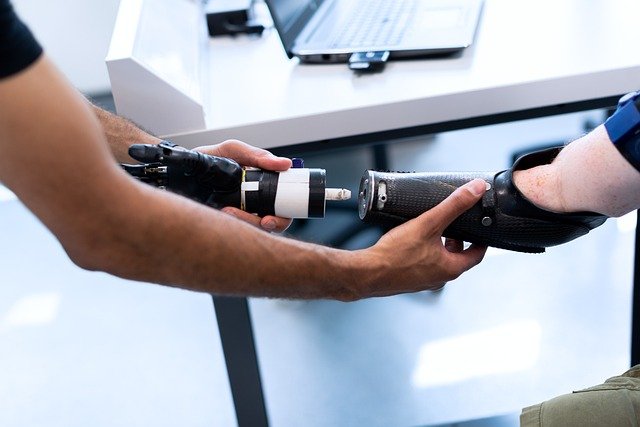
There are different kinds of prosthetic knees, each built to match certain needs, activity levels, and budgets. Understanding the types can help you choose wisely and avoid feeling overwhelmed by the many options.
Single-Axis Mechanical Knees
A single-axis knee is one of the simplest and most commonly used prosthetic knee joints. It has a single hinge that allows the leg to bend and straighten. These knees are lightweight and easy to maintain, making them a good starting point for many users.
For those who are learning to walk again or who do not move very much throughout the day, single-axis knees offer enough support for basic mobility. However, they do not adjust automatically to speed or walking style, which means the user has to work a little harder to control balance and timing.
At Robobionics, we sometimes recommend single-axis knees for users who prefer a simple design or who are still in the early phase of rehabilitation. These knees are often paired with additional features, like manual locks or friction settings, to add more safety.
Polycentric or Multi-Axis Knees
Polycentric knees, also known as four-bar knees, have a more advanced design with multiple pivot points. This setup allows the leg to move more naturally and gives better stability during the first part of a step, when the heel strikes the ground.
These knees are especially helpful for users with a shorter residual limb, as they reduce pressure on the socket and improve limb control. They also make it easier to sit down, stand up, and walk on uneven ground. Because of their design, polycentric knees are a popular choice for everyday use.
They may require a bit more care and understanding to adjust properly, but once set up, they offer smoother and safer movement. At Robobionics, we guide users through the selection and alignment process to ensure the joint matches their walking habits and needs.
Microprocessor-Controlled Knees
Microprocessor knees represent the most advanced option available today. These knees use smart sensors and onboard computers to read how the user is moving and adjust the resistance and stability of the joint in real time.
This means the knee can stiffen when needed for support and relax when it’s time to bend. Whether walking fast, slow, up stairs, or on uneven ground, the knee constantly adapts. For active users or those looking for the most natural walking pattern, a microprocessor knee can be life-changing.
These knees do require battery charging and a bit more training at the start, but the long-term benefits—like improved balance, reduced risk of falls, and better energy use—are often worth the extra care. Robobionics provides hands-on training and ongoing support for all users of microprocessor-controlled knees.
Choosing the Right Knee Joint for Your Lifestyle

Not all users need the most advanced knee, and not all situations require the same level of technology. Choosing the right joint means understanding your daily routine, your physical strength, and what gives you peace of mind.
Matching the Knee to Your Activity Level
Your level of daily movement plays a big role in what kind of knee joint will suit you best. If your routine involves basic indoor movement—like moving from room to room, sitting, standing, or doing simple tasks—a basic mechanical knee might be enough.
For users who walk longer distances, go out often, or need to navigate stairs and slopes, a polycentric or microprocessor knee may offer more control and safety. These users benefit from knees that adjust quickly and respond to their movement without constant conscious effort.
At Robobionics, we assess each user’s lifestyle during the fitting process. This helps us suggest a knee that fits their goals—whether it’s returning to work, playing with grandchildren, or taking a morning walk in the park.
Considering Strength, Balance, and Coordination
Not all above-knee users have the same muscle strength or coordination. Some people may have had long hospital stays, injuries, or conditions that weaken their muscles. Others may be more physically active and ready for a more responsive prosthetic.
The right knee should work with your body, not against it. If balance is a concern, we may recommend a knee with extra stability features or built-in locking mechanisms. If the user has strong control and quick reaction time, a more dynamic knee may offer better freedom of movement.
We always begin with a physical evaluation and training exercises to test how well the user can manage different types of knees. This approach ensures a smoother transition and avoids unnecessary frustration later.
Factoring in Budget and Support Needs
Cost is a real concern for many users. Mechanical knees are usually more affordable and easier to maintain. Microprocessor knees are more expensive but offer higher performance and comfort. Both can be excellent options, depending on the user’s needs and priorities.
At Robobionics, we’re committed to helping users find the best value. We explain the total cost, including fittings, training, maintenance, and upgrades. We also offer payment plans, support through government schemes, and guidance for CSR and insurance-based funding.
No one should have to settle for less due to lack of information. We believe the right prosthetic knee is not always the most expensive—it’s the one that works best for the person wearing it.
Training and Adaptation After Fitting the Knee
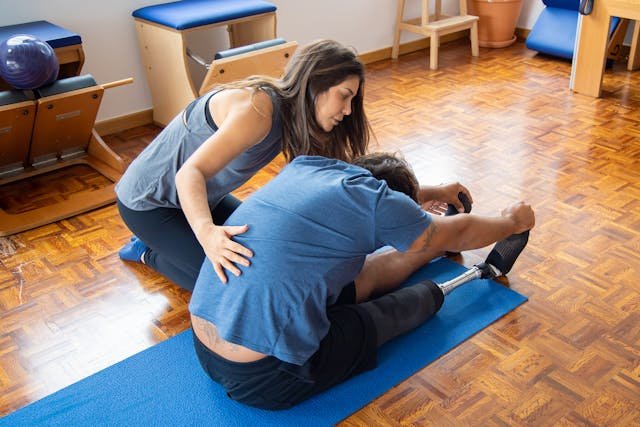
Once the knee joint is chosen and fitted, the journey isn’t over—it’s just beginning. Learning to walk with a prosthetic knee takes patience, practice, and the right guidance.
Learning to Trust the Knee
For many above-knee users, learning to trust the prosthetic knee is a major step. In the beginning, there’s often fear that the knee might bend too quickly, or not bend at all when it should. This fear can lead to stiff walking or hesitation.
The solution is consistent, guided training. Our physiotherapy partners work closely with users to teach safe weight-shifting, controlled stepping, and body posture. With time, users start to feel more secure with their knee and begin to walk with more confidence.
Trust grows with experience. Every successful step, every smooth turn, and every stable pause builds that trust. At Robobionics, we ensure each user has the training tools and emotional support they need during this stage.
Practicing on Different Surfaces and Speeds
Real life doesn’t happen on smooth, flat surfaces. That’s why we help users train on ramps, grass, stairs, and uneven floors. Each new surface teaches the body how to adjust, balance, and control the knee joint properly.
For mechanical knees, practice focuses on timing and rhythm. For microprocessor knees, it includes understanding how the sensors work and what to expect from each movement. We guide users to listen to their body and feel the knee respond, which makes every step more natural.
Learning to vary walking speed is also important. Some knees respond differently to fast or slow movement. Training includes this variation to make daily movement—like walking through a market or catching a bus—more intuitive.
Monitoring Progress and Making Adjustments

As the user grows more active, the way they use their prosthetic knee may change. The socket might feel looser, or the alignment might need small adjustments. Regular follow-ups help track this progress and keep everything working smoothly.
We always recommend early reporting of any discomfort or change in walking style. Adjustments are normal and expected, especially in the first few months. The better the fit and function, the more confident and energetic the user feels.
Robobionics offers free follow-up sessions, remote guidance, and quick service support. We believe every user deserves consistent care—not just at the beginning, but throughout their journey.
Real User Experiences with Different Knee Joints
Understanding the technology is one part of the journey—but hearing how real people adapt to and live with their prosthetic knee joints can bring clarity and confidence to anyone just starting out. Every user has a different story, shaped by their lifestyle, recovery process, and the knee they choose.
Learning to Walk Again After a Transfemoral Amputation
Aman, a 45-year-old farmer from Nashik, lost his leg above the knee in an accident. He had never worn a prosthetic before and didn’t know what to expect. During his first visit to Robobionics, we walked him through his options and helped him try a few different mechanical knee joints. Initially, he struggled with balance, especially while walking on uneven farmland.
After a few weeks of rehab using a basic polycentric knee, he began to feel more stable. The joint allowed him to sit and stand easily, and he appreciated the added stability the design gave him. Over time, as his strength improved, Aman expressed interest in upgrading to a microprocessor knee for better support on hilly terrain.
Today, Aman is back working in his fields and says he feels “more secure in every step.” His story reminds us that recovery is not about speed—it’s about finding the right match and growing with it.
Regaining Confidence with a Microprocessor Knee
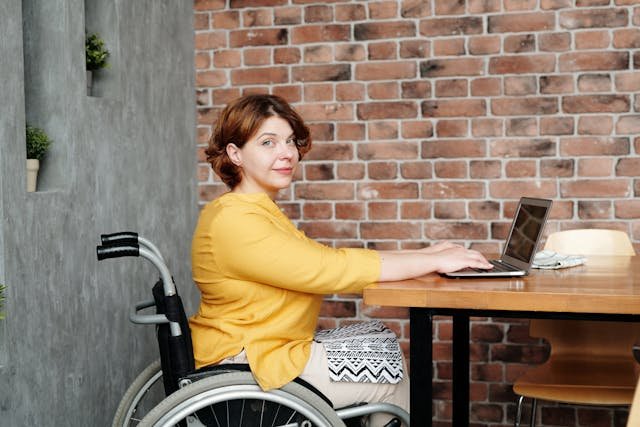
Sarla, a 62-year-old retired teacher from Bengaluru, had an above-knee amputation due to diabetes-related complications. She was hesitant to start using a prosthetic, especially after hearing that walking again would be difficult. Her family encouraged her to try, and she began her journey with Robobionics.
Given her age and balance concerns, we recommended a microprocessor-controlled knee for greater safety. After a few sessions with our partner rehab center, Sarla learned how to trust the knee’s sensors. It adjusted to her speed, supported her on stairs, and even made indoor walking more stable.
Now, Sarla enjoys her morning walks again and has even returned to her yoga class. She often tells others in her support group that the “knee gave her back her peace of mind.” Her experience shows how the right technology can empower users of any age.
Staying Active with a Polycentric Mechanical Knee
Ravi, a 29-year-old software engineer in Pune, wanted to stay active after his above-knee amputation. He chose a lightweight polycentric knee for its smooth movement and compact design. Since he walked a lot for his commute and loved weekend hikes, he needed a joint that could support both urban and outdoor activity.
Through our home-based gamified rehab program, Ravi improved his gait and learned how to adjust to different surfaces. Over time, he developed a rhythm that felt natural and efficient. While he considered switching to a microprocessor knee, he found his polycentric knee was meeting his needs well—without needing charging or added maintenance.
Today, Ravi continues to work full-time, travel independently, and even lead sessions at local peer support meets. His journey proves that with the right fit and mindset, mechanical knees can still offer powerful performance.
Conclusion
The prosthetic knee joint is not just a part of your device—it’s a part of your movement, your safety, and your daily freedom. For above-knee amputees, choosing the right knee joint means choosing how you live, how you walk, and how you feel in your body.
At Robobionics, we’re here to make that choice easier. With advanced options, expert guidance, and caring support, we help you find a knee that supports your goals, your comfort, and your future.
Book a free demo or consultation with Robobionics today—and take your next step with the confidence of a knee joint that moves with you.



